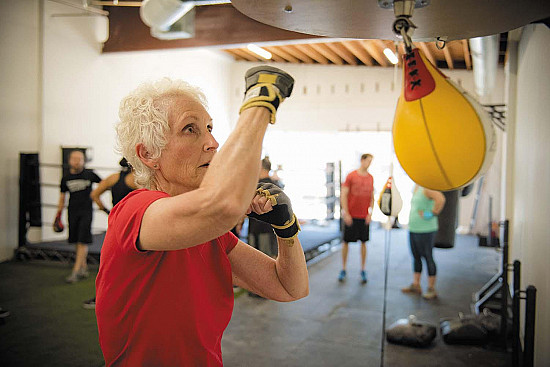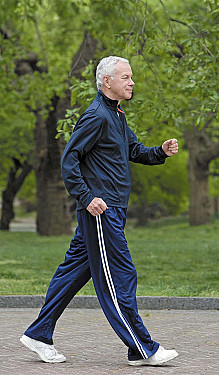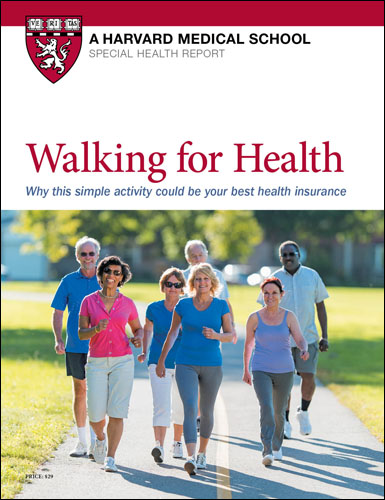Power up your walking routine
Bored with looping the neighborhood? Add some kick to your stride.
- Reviewed by Toni Golen, MD, Editor in Chief, Harvard Women's Health Watch; Editorial Advisory Board Member, Harvard Health Publishing; Contributor
 Little can soothe us like the sound and feel of our feet hitting the ground, again and again, while we walk. Long the most popular form of movement among American adults, walking gained fresh appeal during the pandemic, when more than two-thirds of physically active adults reported it became their preferred exercise.
Little can soothe us like the sound and feel of our feet hitting the ground, again and again, while we walk. Long the most popular form of movement among American adults, walking gained fresh appeal during the pandemic, when more than two-thirds of physically active adults reported it became their preferred exercise.
Several years downstream, however, maybe those endless loops around the neighborhood or track are feeling a little humdrum. Or maybe you need more than comfort from your walking routine. That's a sign to kick it up a notch, says Dr. Lauren Elson, a physiatrist (doctor who specializes in physical medicine and rehabilitation) at Harvard-affiliated Spaulding Rehabilitation Network.
There's no question regular walks are better than staying in your chair, but stepping up your regimen can pay off in key ways — even if it just means you stick with it. "We know all the problems associated with sitting that walking counteracts, but anything that's not inspiring can be difficult to keep doing," Dr. Elson says. "There's almost no good reason not to walk."
Pace counts
A wealth of research supports walking's many health benefits, suggesting it improves circulation and heart health, strengthens bones and immune response, helps control weight, and lowers the risk of dementia. But a new analysis suggests it's not just the activity that matters, but the pace.
Published online Sept. 12, 2022, by JAMA Internal Medicine, the study — which collected health data on more than 78,000 people (average age 61, 55% women) from 2013 to 2015 — found that their risk of heart disease, cancer, and premature death dropped by 10% over the following seven years for every 2,000 steps they logged each day, with the benefit peaking at 10,000 daily steps. But participants who walked more briskly — about 80 steps per minute — reaped greater benefits, lowering their health risks more than slower-walking peers.
Walking can still fall short, Dr. Elson says, since it works primarily the legs but not many other muscles or body areas. "Adding a bit of oomph to your walking routine could make it more efficient and add some core strength," she says.
Ways to step it up
With a dash of creativity and flexible thinking, you can easily power up your walking routine. Dr. Elson suggests considering the following strategies:
Walking poles transform a legs-only activity into a full-body workout. There are multiple types, which go by such names as trekking poles and Nordic walking poles. Some are designed with rubber tips to grip the pavement, while others are pointed to add traction on trails. Using them works your arms, back, and shoulders, burning more calories in the process. "Walking poles can prevent stability problems and also help with lower-body discomfort," she says. "And because of that cross-body action, they add a little bit of core strength as well."
High-intensity bursts of speed increase heart rate, breathing, and muscle action for short, defined periods. Try alternating five minutes of your typical walking pace with 30-second intervals of speed walking, skipping, jogging, or sprinting. Repeat as desired. Also known as high-intensity interval training, or HIIT, this pattern "definitely improves your cardiovascular fitness more than straight walking," Dr. Elson says.
Resistance exercise "breaks" strategically break your stride while boosting overall strength. Rotating five-minute periods of walking with squats, pushups, or other resistance exercises "is a great way to not quite do HIIT, but to supplement cardiovascular exercise with strength and power work," she says. These types of activities are best saved for a park or backyard, as they're more difficult to squeeze in on a sidewalk.
Music, podcasts, or books on tape engage your brain while you add to your step count. Cranking up your favorite tunes can motivate you to walk to the beat, and exercise can also seem easier when you're focused on your playlist. Dr. Elson makes her walks perform double duty by listening to audiobooks. "It's a chance to kill two birds with one stone," she says. "If I don't have time to sit and read, I can at least get in some 'reading' while I exercise." Pay extra attention to cars, however.
Weighted backpacks enable you to firm up your leg muscles and give your heart and lungs an extra workout while walking. Fill a well-padded backpack with light weights — between five and 10 pounds to start — of dumbbells, books, or cans. But this tweak should only be attempted by seasoned walkers with no joint or muscle problems, which might be aggravated by the extra load. "Don't start a walking regimen doing this right away," she says. "View this as a higher-intensity option."
Image: © IPGGutenbergUKLtd/Getty Images
About the Author

Maureen Salamon, Executive Editor, Harvard Women's Health Watch
About the Reviewer

Toni Golen, MD, Editor in Chief, Harvard Women's Health Watch; Editorial Advisory Board Member, Harvard Health Publishing; Contributor
Disclaimer:
As a service to our readers, Harvard Health Publishing provides access to our library of archived content. Please note the date of last review or update on all articles.
No content on this site, regardless of date, should ever be used as a substitute for direct medical advice from your doctor or other qualified clinician.
















